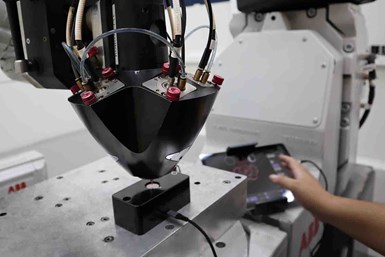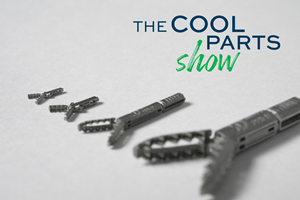Meltio Augments Wire-Laser Metal 3D Printing Technology for Easier Use, Reliability
The latest technology was developed to make the M450 metal 3D printer, Engine CNC Integration and Engine Robot Integration faster, more precise, easier to use and more reliable.
The alignment of each laser is critical so they hit the exact point where the energy is concentrated: the misalignment of the lasers leads to energy inefficiency and defects on the 3D printed parts. The camera makes the calibration process easy to follow. Photo Credit: Meltio
Meltio, a laser metal deposition technology manufacturer, has developed three more metal 3D printing solutions to further enable the use and reliability of its wire-laser metal 3D printing technology. The Meltio M450 metal 3D printer, Meltio Engine CNC Integration and Meltio Engine Robot Integration will be faster, more precise, easier to use and more reliable.
In particular, the tailor-made Meltio Horizon software and Laser Calibration System are designed to assist engineers in their additive manufacturing production workflow. Both technological solutions developed by Meltio’s engineering team represent a further step in the company’s strategy to eliminate the barriers that have prevented metal AM from having a significant presence in many industrial sectors.
“We have developed the Meltio Horizon software and the Laser Calibration System with the aim of facilitating the use of Meltio’s metal 3D printing technology for industries around the world. It should be noted that metal additive manufacturing has historically been associated with complex and expensive software, limited to the use of very few people because it was very specialized,” says Ángel Llavero, Meltio CEO. “At Meltio, with the launch of our new software, we facilitate and shorten the learning time for you to democratize metal 3D printing so that your software is accessible and easy-to-use for many different profiles within a company. The Laser Calibration System will give industrial companies a new tool to be able to work with guaranteed reliability in the creation of their metal parts.”
The company says Meltio Horizon is a proprietary toolpath generator software that ensures a fully tailored customer experience around its plug-and-play metal 3D printer, the Meltio M450, with its own unique features and custom-developed Meltio print and material profiles included. The software solution is tailored to use the wire-laser metal deposition process with the Meltio M450. Until recently, Meltio users have been reliant on using third-party Fused Filament Fabrication (FFF) slicers to prepare tool paths for the Meltio M450.
In addition to traditional slicing parameters used in FFF software (such as layer height, line width, print speed and support materials), the Meltio Horizon provides tailor-made access to Meltio’s laser-wire process and material-specific parameters such as laser power, dual wire and hot wire settings.
With the Meltio Horizon software, all of the material-related settings are directly in the slicing software, enabling full control and just a single profile. This also enables the creation of more specialized printing profiles, with the power to directly control the laser and hot wire on a “per slicing feature” basis, rather than being set for the full part.
This slicer is currently only compatible with the Meltio M450 metal 3D printer. For Meltio Engines (CNC and Robot Integration), the company is currently working on developing its open software ecosystem partnerships that enables the generation of 5-Axis G-Codes.
-
Read how CNC Engineering and Meltio collaborated to design a solution that combines the power and reliability of FANUC CNC with cutting edge additive manufacturing technology.
- Listen to this episode of The Cool Parts Show to hear about Meltio’s wire or powder directed energy deposition technology.
Related Content
DMG MORI: Build Plate “Pucks” Cut Postprocessing Time by 80%
For spinal implants and other small 3D printed parts made through laser powder bed fusion, separate clampable units resting within the build plate provide for easy transfer to a CNC lathe.
Read MoreBMW Expands Use of Additive Manufacturing to Foster Production Innovations
The BMW Group is manufacturing many work aids and tools for its own production system using various 3D printing processes, with items such as tailor-made orthoses for employees, teaching and production aids, and large, weight-optimized robot grippers, which are used for such things as carbon fiber-reinforced polymer roofs and entire floor assemblies.
Read MoreMicro Robot Gripper 3D Printed All at Once, No Assembly Required: The Cool Parts Show #59
Fine control over laser powder bed fusion achieves precise spacing between adjoining moving surfaces. The Cool Parts Show looks at micro 3D printing of metal for moving components made in one piece.
Read MoreBig Metal Additive: The Difference Between a Shape and a Part Is Quality
Preparing to scale directed energy deposition to ongoing full production is not a technological challenge: DED is ready. But it is an organizational challenge, says the company founder. Here is what it means to implement a quality system.
Read MoreRead Next
Postprocessing Steps and Costs for Metal 3D Printing
When your metal part is done 3D printing, you just pull it out of the machine and start using it, right? Not exactly.
Read MoreCrushable Lattices: The Lightweight Structures That Will Protect an Interplanetary Payload
NASA uses laser powder bed fusion plus chemical etching to create the lattice forms engineered to keep Mars rocks safe during a crash landing on Earth.
Read MoreAlquist 3D Looks Toward a Carbon-Sequestering Future with 3D Printed Infrastructure
The Colorado startup aims to reduce the carbon footprint of new buildings, homes and city infrastructure with robotic 3D printing and a specialized geopolymer material.
Read More





















